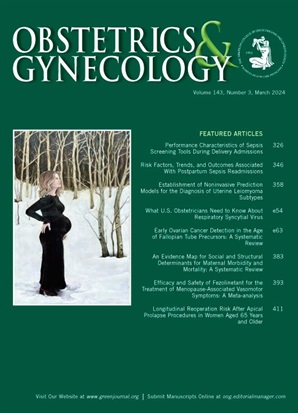p53异常子宫内膜癌患者子宫内膜厚度的超声测量。
IF 4.7
2区 医学
Q1 OBSTETRICS & GYNECOLOGY
引用次数: 0
摘要
目的评价经阴道超声(TVUS)在按p53状态分层的子宫内膜癌患者中的诊断前子宫内膜厚度,以评估子宫内膜厚度作为筛查工具在该患者群体中的准确性。方法:我们对2004年至2017年间诊断为子宫内膜癌并接受诊断前TVUS的患者进行了回顾性队列研究。利用组织芯片,我们根据p53异常免疫组化染色的存在与否,将病例分为p53异常(p53abn)或p53野生型(p53wt)。病例分层根据确定的筛选阈值4毫米或更小的子宫内膜厚度用于评估绝经后出血。人工提取临床资料。所有患者均接受手术分期,包括子宫切除术。采用Student t、χ2和Fisher精确检验来评估与p53abn子宫内膜癌相关的变量。采用多变量logistic回归来评估与子宫内膜癌病例相关的变量,TVUS筛查假阴性结果定义为子宫内膜厚度小于或等于4mm。结果133例患者中,60例(45.1%)被分类为p53abn, 73例(54.9%)被分类为p53wt。该队列的中位年龄为66岁(四分位数范围为58-74岁),中位体重指数(BMI)为31.3(四分位数范围为26.8-37.3)。子宫内膜中位厚度为16 mm(四分位间距9-22 mm), 48例(36.1%)患者在TVUS上发现粘膜下或壁内平滑肌瘤。与p53wt患者相比,诊断为p53abn子宫内膜癌的患者更有可能有更薄的子宫内膜测量(10 mm[四分位数范围5-18.5 mm] vs 18 mm[四分位数范围13-23 mm], P<.001)。在4 mm或更小的阈值下,p53abn子宫内膜癌患者比p53wt子宫内膜癌患者更有可能筛查为阴性(25% vs 4.1%, P< 0.001)。在多变量分析中,子宫内膜厚度阈值≤4 mm、较低的BMI(比值比[or] 0.906, 95% CI, 0.833-0.986, P= 0.023)和p53状态(比值比[or] 9.415, 95% CI, 2.441-36.309, P= 0.001)仍然是假阴性筛查结果的重要预测因素。结论在诊断为p53abn型子宫内膜癌的患者中,TVUS评估子宫内膜厚度似乎不是一种可靠的筛查方法。使用子宫内膜厚度作为子宫内膜癌的筛查试验可能会因为假阴性结果而错过相当一部分p53abn病例。在绝经后出血的情况下,应强烈考虑子宫内膜组织取样。本文章由计算机程序翻译,如有差异,请以英文原文为准。
Ultrasonography-Based Measurements of Endometrial Thickness in Patients With p53 Abnormal Endometrial Carcinomas.
OBJECTIVE
To evaluate prediagnostic endometrial thickness measured by transvaginal ultrasonography (TVUS) in a cohort of patients with endometrial cancer stratified by p53 status to assess accuracy of endometrial thickness as a screening tool in this patient population.
METHODS
We conducted a retrospective cohort study of patients diagnosed with endometrial cancer who underwent prediagnostic TVUS between 2004 and 2017. Using a tissue microarray, we categorized cases as p53 abnormal (p53abn) or p53 wild type (p53wt) according to the presence or absence of p53 aberrant immunohistochemistry staining. Cases were stratified according to established screening thresholds of 4-mm or less endometrial thickness used to evaluate postmenopausal bleeding. Clinical data were manually abstracted. All patients included underwent surgical staging, including hysterectomy. Student t, χ2, and Fisher exact tests were performed to assess for variables associated with p53abn endometrial carcinoma. Multivariate logistic regression was performed to assess variables associated with cases of endometrial cancer, with false-negative TVUS screening results defined as an endometrial thickness of 4 mm or less.
RESULTS
Of the 133 patients identified, 60 (45.1%) were classified as p53abn and 73 (54.9%) as p53wt. The median age of the cohort was 66 years (interquartile range 58-74 years), and median body mass index (BMI) was 31.3 (interquartile range 26.8-37.3). Median endometrial thickness was 16 mm (interquartile range 9-22 mm), and 48 patients (36.1%) had submucosal or intramural leiomyomas identified on TVUS. Patients diagnosed with p53abn endometrial cancers were more likely to have thinner endometrial measurements compared with p53wt cases (10 mm [interquartile range 5-18.5 mm] vs 18 mm [interquartile range 13-23 mm], P<.001). At a threshold of 4 mm or less, patients with p53abn endometrial cancer were more likely to screen negative compared with patients with p53wt endometrial cancer (25% vs 4.1%, P<.001). In multivariate analysis, a threshold of 4 mm or less for endometrial thickness, lower BMI (odds ratio [OR] 0.906, 95% CI, 0.833-0.986, P=.023), and p53 status (OR 9.415, 95% CI, 2.441-36.309, P=.001) remained significant predictors of false-negative screening results.
CONCLUSION
Endometrial thickness assessed by TVUS does not appear to be a reliable screening method in patients diagnosed with p53abn endometrial cancers. The use of endometrial thickness as a screening test for endometrial cancer may miss a significant portion of p53abn cases because of false-negative results. In the presence of postmenopausal bleeding, endometrial tissue sampling should be strongly considered.
求助全文
通过发布文献求助,成功后即可免费获取论文全文。
去求助
来源期刊

Obstetrics and gynecology
医学-妇产科学
CiteScore
11.10
自引率
4.20%
发文量
867
审稿时长
1 months
期刊介绍:
"Obstetrics & Gynecology," affectionately known as "The Green Journal," is the official publication of the American College of Obstetricians and Gynecologists (ACOG). Since its inception in 1953, the journal has been dedicated to advancing the clinical practice of obstetrics and gynecology, as well as related fields. The journal's mission is to promote excellence in these areas by publishing a diverse range of articles that cover translational and clinical topics.
"Obstetrics & Gynecology" provides a platform for the dissemination of evidence-based research, clinical guidelines, and expert opinions that are essential for the continuous improvement of women's health care. The journal's content is designed to inform and educate obstetricians, gynecologists, and other healthcare professionals, ensuring that they stay abreast of the latest developments and best practices in their field.
 求助内容:
求助内容: 应助结果提醒方式:
应助结果提醒方式:


